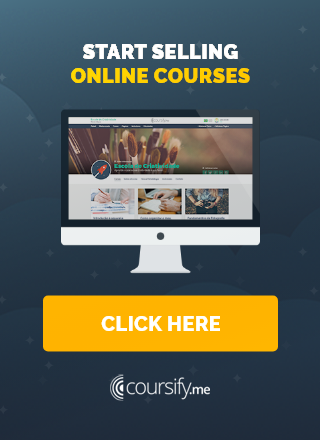Creating online courses: how to set up an eLearning course
As the distance education market has heated up, many professionals and companies have started creating online courses, both as a way to earn extra income and to train employees easily.
Although the idea seems simple, with so many technological resources available today, creating an online course requires planning and some practical tips, which we will cover in this article.

Types of online courses
Depending on the topic, your target audience and the way you deliver content to students, distance learning courses can be designed in a variety of ways.
So to start, let’s look at some of the main types of courses that you can create and sell online.
Corporate training
Courses focused on business training can have different goals and depend on several factors, such as the segment in which the company operates, size and the internal functioning of the organization.
– Benefits of Online Corporate Training for Companies
In general, we can identify five types of eLearning courses that employees need to take.
1. Integration courses
This type of course refers to the training you offer to new hires to update them on the company’s tools, processes and regulations, helping them to feel more comfortable in the new environment.
2. Compliance courses
Part of the integration process, these are mandatory and include the rules and regulations that govern a specific sector. They can address various topics, such as safety at work, first aid and business ethics.
3. Training courses
As the name implies, these courses help employees master the skills they need in the field in which they will work and become even better professionals.
4. Social skills courses
In addition to specific basic skills, employees need social skills to be able to do their job properly and interact well with colleagues and customers. These courses can be geared towards improving communication, leadership, problem solving, time management, decision making, work ethics, conflict management and more.
5. Product knowledge
Creating online courses product usage is very important for companies that sell a particular item or provide a service. This type of material usually includes detailed information about the products, such as their features, benefits and costs, so that the employee has a complete understanding of what the company offers, can talk about it safely and deal with any questions asked by customers.
– 10 profitable niches for online courses
Common courses
Now let’s explore some of the types of courses most commonly developed, with the intention of selling.
1. Leisure courses
These courses focus on subjects related to fun or entertainment. The topics here can be quite varied: from painting and cooking, to gardening and dancing. So, if you are, say, a talented baker, you can create tutorials and sell them online. Obviously these same courses can be used by people who want to work professionally in these areas or professionals who already work in these segments and are looking to improve their knowledge.
– Record tutorial videos: tips to get the best result
2. Professional courses
To create professional online courses you have to be an expert in some subject. People take these courses for professional reasons. For example, they want to learn how to write code, build websites, run a business, etc. The only difference is that they do this outside the corporate environment or in a physical classroom, and choose courses on their own from the options available on the market.
3. Personal development courses
Much sought after today, the purpose of this type of course is to help people gain an understanding of how to face the challenges of everyday life. They may cover topics like leadership, time management, public speaking and negotiation, but in this case, the focus is usually on developing skills that will allow people to live a happier life, rather than achieving professional goals.
4. Coaching courses
In addition to offering content, coaching courses propose some tasks that students should perform, counting on the coach’s feedback and support during the training. They can teach things like staying healthy (nutrition and fitness), addressing business topics (sales and marketing strategy) and addressing self-development (emotional intelligence, confidence and body language).
– How to Offer Online Coaching Courses
Creating online courses: basic guide

As you can see, when it comes to creating online courses, the options are numerous, but regardless of what type of course you are going to build, you will need to have a clear strategy in mind of how to do it.
The steps listed below are based on the experience of several tutors and address the entire development process, from setting goals and target audiences, to publishing the content.
Follow this practical summary that we have prepared on how to create online courses.
1. Planning
Your course development process will be as productive as your pre-planning. By taking the time to prepare, you are solving problems before they have a chance to happen. Here’s what you need to do first:
Set your goals
This first step does not mean making a list of goals that you intend to achieve. This is what results you want to achieve after your students complete your online course. Therefore, define the course objective by answering this question: “What should a student be able to do after finishing my course?
The answer to this question can vary, such as, for example, “the student must be able to”:
- double his number of sales;
- build a website;
- identify a problem in a software and fix it, etc.
Realize that it is a good idea to be specific, so that your course proposal is more attractive to the student.
Don’t promise the world, be clear about what the course will teach and what people can expect when they enroll. And, most importantly, deliver what was promised.
Know your target audience
Trying to create online courses that suit everyone is a futile effort. You need to do this for a certain reason and for a specific audience. Before you start developing your content, take a closer look at your potential students and try to create a buyer persona.
– How to create buyer personas?
Start by finding out the answers to some basic questions:
- What is the age group of your students?
- What position do they occupy? (Are they sales representatives, HRs, programmers, start-up entrepreneurs, etc.?)
- What are their demographic characteristics? (Educational level, geographic location, socioeconomic status, etc.?)
- Have they received previous training in this area? Do they know the subject well?
All of this information will help you design content that communicates and best serves your target audience.
This will not only make the student experience better, it will also help to attract more and more customers.
2. Content
The next thing you should think about when creating online courses is how you will present your course to the public.
The way you consider best to teach and transmit your knowledge will define the choice of the course format (video, presentations, handouts, audios, etc.) and the type of software you will need.
– How to create professional presentations
An online course doesn’t have to offer just one content format. You can perfectly record video lessons and make handouts and pdfs available as support material. Some modules of your course can also be delivered in the form of powerpoint presentations, using various resources such as animations and graphics, for example.
Remember that the videos are on the rise and promote greater engagement by the public. So, if you want to attract more attention, check out our posts on how to record videos at home and do your best!
– How to record videos at home
With a simple smartphone camera, microphone and editing software that you find for free on the internet, it is possible to create good quality videos.
Written materials are even easier. You can even take advantage of other content you already have, such as blog posts, to facilitate the development of that content.
The tip is: make a plan of how your course will develop, record a class or set up a presentation and show someone you know to get feedback.
– Checklist for creating online courses
Make improvements until you have full approval and then move on to the publishing phase.
3. Learning platform
The easiest and most comfortable way to publish your course online and manage the learning process of your students is through a Learning Management System (LMS).
– Whats is a Learning Management System
This type of software, developed especially to facilitate online education, will allow you to automate many functions, such as enrollment, course organization, access to classes, monitoring of students, monitoring of results and online payments.
If you are creating online courses and want to become a successful seller, opt for a platform that will allow you to host, deliver and sell your courses to end users in an integrated way, so that you can manage everything from the creation of the course to the marketing and payment processing.
Keep in mind that this is the main tool that you will use throughout the development process.
If you are new to building courses and have little knowledge of technology, you will need to choose an easy-to-use tool that allows you to create courses as quickly as possible, while meeting all your creation, advertising and sales needs. For example, if you want to create interactive courses with questionnaires, videos and audios, you need software that offers all of these features.
The Coursify.me is an eLearning platform completely dynamic and customizable, providing all the features you might need.
Present in more than 60 countries, Coursify.me is the perfect solution for those who want to create and sell courses online.
– Learn how to sell online courses
Complete platform, ready to use in the SaaS model, you can upload your content through your computer or other platforms such as YouTube, Dropbox and Vimeo, and your classes will be ready to be attended.
With a friendly and intuitive design, anyone can use Coursify.me, whether as a teacher or student, without having to understand computing for that.
To know more, visit our website, test the platform and learn why we are the best option for you to start creating online courses.

